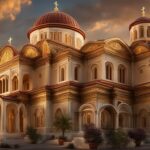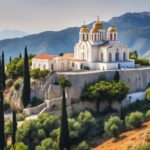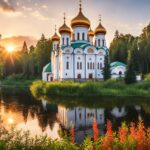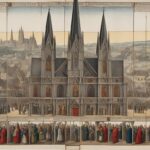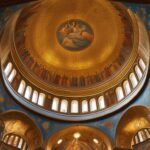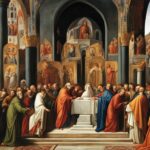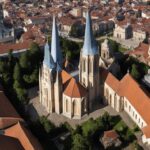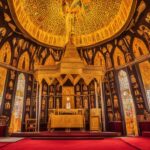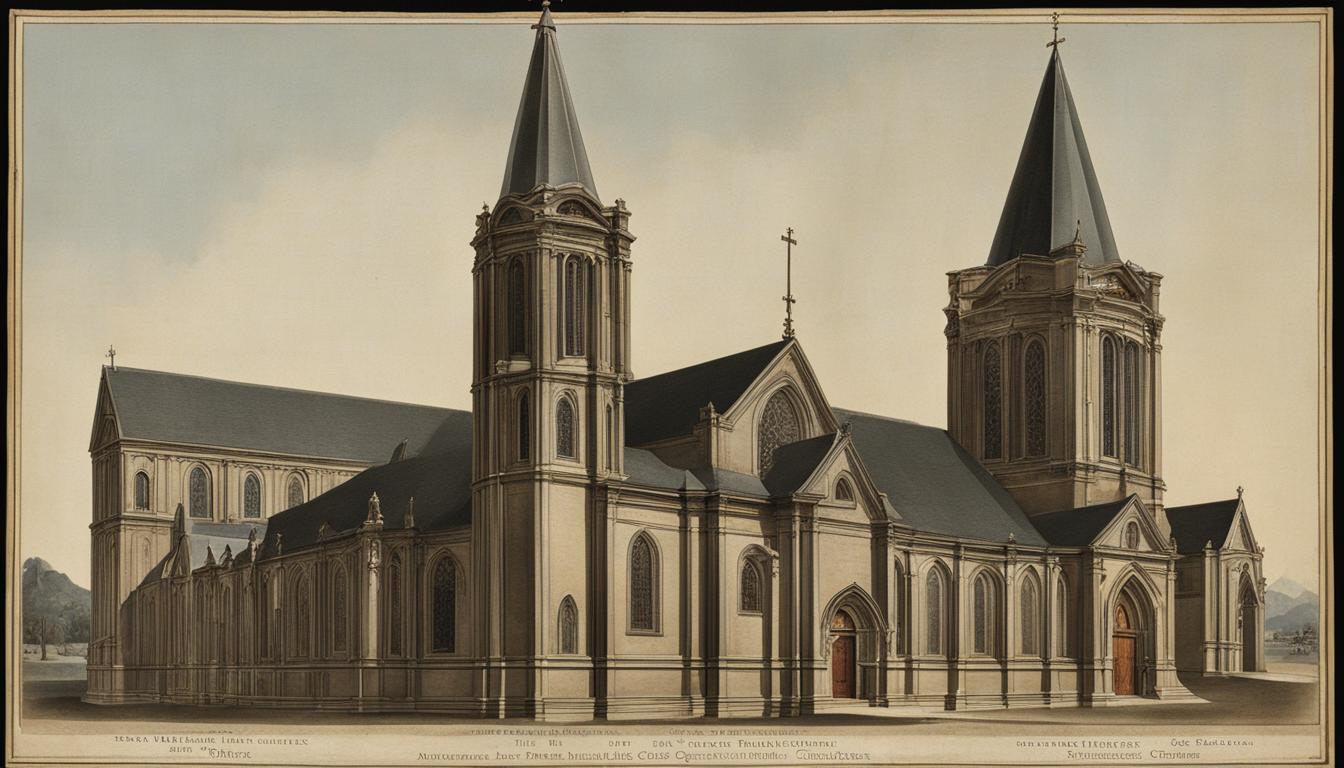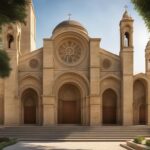The Russian Orthodox Church, also known as the Russian Orthodox religion, is a prominent branch of Russian Christianity and Eastern Orthodoxy. With a rich history rooted in Russian religious traditions, the Russian Orthodox Church holds a significant place in the development of Russian religious history and the Eastern Orthodox Christianity.
Originating from the Byzantine Empire, the Russian Orthodox Church was introduced to Russia through the efforts of Greek missionaries who sought to Christianize the region. Over time, the church established its own hierarchy and doctrines, becoming autonomous from the Byzantine Empire. Throughout history, the Russian Orthodox Church faced challenges and conflicts with political rulers, yet it managed to survive and flourish, playing a pivotal role in Russian culture and spirituality.
Today, the Russian Orthodox Church continues to thrive and exert its influence in modern Russia. It serves as a vital institution in shaping public opinion, social issues, and political discourse. The church remains deeply involved in charitable activities, education, and cultural preservation, providing spiritual guidance and moral support to the Russian people.
Key Takeaways:
- The Russian Orthodox Church has a rich history and is the largest denomination of Orthodox Christianity.
- It originated from the Byzantine Empire and spread to Russia through the Christianization efforts of Greek missionaries.
- The Russian Orthodox Church has its own hierarchy and doctrines, separate from the Byzantine Empire.
- Throughout history, it has played a significant role in shaping Russian culture and spirituality.
- Today, the Russian Orthodox Church continues to influence public opinion, social issues, and political discourse in Russia.
Origins and Founders
The origins of the Russian Orthodox Church can be traced back to the Christianization efforts of Byzantine missionaries in the 9th century. While tradition holds that the church was founded by Andrew the Apostle, the actual establishment of Christianity in Russia can be attributed to the conversion of Princess Olga of Kiev and Grand Prince Vladimir of Kiev. These influential figures played a significant role in bringing Orthodox Christianity to the region.
According to legend, Andrew the Apostle visited the territory of present-day Ukraine and planted a cross in Kiev, symbolizing the future establishment of Christianity in the land. However, the organized and institutionalized form of the Russian Orthodox Church that exists today owes its existence to the efforts of Byzantine missionaries who were sent to spread the faith.
“The conversion of Princess Olga of Kiev and Grand Prince Vladimir of Kiev played a significant role in the establishment of the church in Russia.”
Princess Olga, who ruled as regent in the late 10th century, was the first member of the ruling elite to convert to Christianity. Her baptism in Constantinople in 957 initiated the process of Christianization in Kievan Rus’. Her grandson, Grand Prince Vladimir, further solidified the dominance of Christianity by baptizing the entire population of Kiev in 988. This event marked a turning point in the history of the Russian Orthodox Church and laid the foundation for its subsequent development and influence.
| Origins and Founders | Key Points |
|---|---|
| The Russian Orthodox Church traces its origins to the efforts of Byzantine missionaries in the 9th century. | Byzantine missionaries played a crucial role in spreading Christianity in Russia. |
| Andrew the Apostle is traditionally considered the founder of the Russian Orthodox Church, although the church was actually established by grand Prince Vladimir of Kiev and Princess Olga. | Princess Olga’s baptism in 957 and the mass baptism of Kiev in 988 contributed to the establishment of the church. |
Key Beliefs and Doctrines
The Russian Orthodox Church shares core beliefs and doctrines with Orthodox Christianity, which is characterized by its adherence to traditional teachings and practices. Central to the Russian Orthodox Church’s beliefs is the recognition of the Holy Trinity, comprising God the Father, God the Son (Jesus Christ), and God the Holy Spirit. The church views the Holy Trinity as the ultimate mystery and source of divine revelation.
Orthodox Christianity emphasizes the divine nature of Jesus Christ and his role as the Son of God. It teaches that Jesus Christ, through his crucifixion, resurrection, and ascension, redeemed humanity from sin and death. The Russian Orthodox Church venerates icons as sacred images representing Christ, the Virgin Mary, saints, and biblical events. Iconography is considered a means of spiritual connection and reflection.
The church places great significance on the sacraments, also known as mysteries, which are believed to convey divine grace. Baptism is considered the gateway to the church and marks the initiation into the Christian faith. Confession, or the Sacrament of Repentance, allows individuals to seek forgiveness for their sins. The Eucharist, known as the Divine Liturgy, is the central act of worship where the congregation partakes in the body and blood of Christ.
The Holy Trinity
“We venerate the Holy Trinity as the Father, the Son, and the Holy Spirit. It is through the Holy Trinity that we come to understand the nature of God and His divine plan for salvation.”
Orthodox Christianity places a strong emphasis on prayer and the liturgical life of the church. Worship services are characterized by their rich ceremonial traditions, including intricate chants, incense, and the use of liturgical vestments. The Russian Orthodox Church follows the Byzantine liturgical tradition and offers different services based on the liturgical calendar, such as the Divine Liturgy, Vespers, and Matins.
Overall, the Russian Orthodox Church’s beliefs and doctrines form the foundation of its spiritual and religious practices, guiding the lives of its followers and providing a sense of unity and continuity with the ancient traditions of Orthodox Christianity.
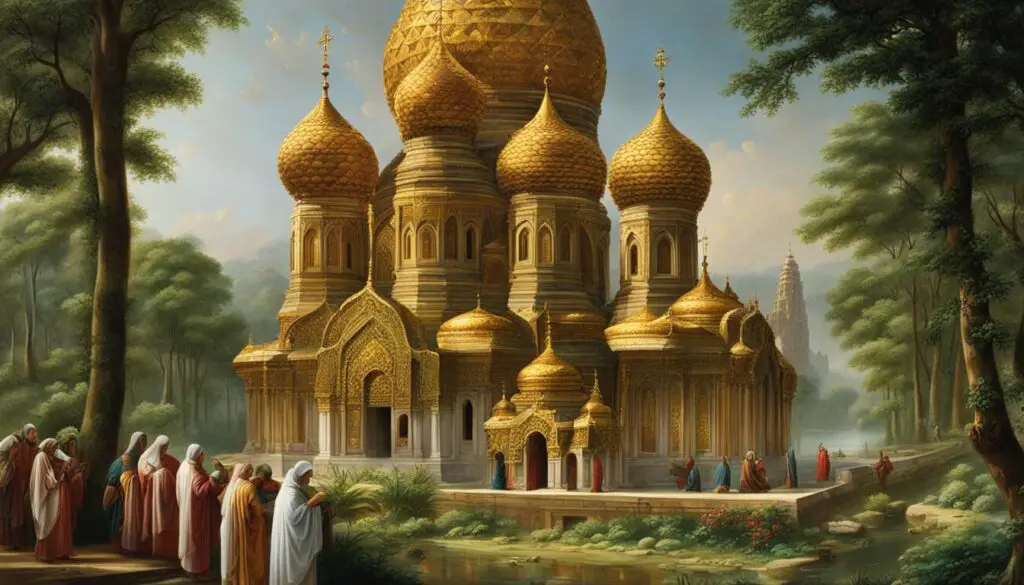
Historical Significance
The Russian Orthodox Church holds immense historical significance and has played a pivotal role in shaping Russian history and culture. As the largest denomination of Orthodox Christianity, the church has been a central institution in the lives of the Russian people for centuries.
Throughout history, the Russian Orthodox Church has been a symbol of national identity and unity. It provided spiritual guidance and support to the Russian people, especially during times of foreign occupation and political unrest. The church’s influence extended beyond the realm of religion, as it had close ties with the ruling powers and played a significant role in political affairs.
Influence on Russian Culture
The Russian Orthodox Church has had a profound impact on Russian culture, influencing various aspects of artistic expression, literature, architecture, and social traditions. Iconography, a prominent feature of Orthodox worship, has inspired countless works of art, with icons becoming an integral part of Russian religious and cultural life. The church’s liturgical practices and hymns have also influenced Russian music and choral traditions.
The Russian Orthodox Church’s historical significance cannot be overstated. It has shaped the course of Russian history, provided spiritual solace to the Russian people, and contributed to the development of Russian culture and traditions. Today, it continues to play a vital role in the spiritual and cultural life of Russia, serving as a symbol of national identity and a vehicle for the preservation of Russian heritage.
Denominational Split or Schisms
The history of the Russian Orthodox Church is marked by several significant schisms and divisions, which have had a lasting impact on its development and structure. These schisms arose due to theological disagreements, political conflicts, and the desire for independence and autonomy within the church.
One of the most notable schisms in the Russian Orthodox Church occurred in the 15th century when the church effectively broke away from the authority of the Patriarchate of Constantinople. This schism led to the establishment of the Moscow Patriarchate, which became the center of religious authority in Russia.
Another significant schism took place in the 17th century with the emergence of the Old Believers. The Old Believers rejected the liturgical reforms introduced by the church and insisted on adhering to traditional practices. This division led to a period of persecution and isolation for the Old Believers, who were seen as dissenters by the official church.
The Moscow Patriarchate
After the split from Constantinople, the Moscow Patriarchate emerged as the leading authority within the Russian Orthodox Church. The Patriarch of Moscow, as the highest-ranking bishop, held tremendous power and influence over the affairs of the church. The Moscow Patriarchate played a crucial role in shaping the religious, cultural, and political landscape of Russia.
The Old Believers
The Old Believers, also known as the Old Ritualists, formed a dissenting group within the Russian Orthodox Church. They refused to accept the liturgical reforms implemented by the church and sought to preserve the traditional practices and rituals. The Old Believers faced persecution and discrimination from the state and the official church, but they managed to survive and maintain their distinct religious identity.
| Schism | Cause | Consequences |
|---|---|---|
| The split from Constantinople | Desire for independence from the Patriarchate of Constantinople | Establishment of the Moscow Patriarchate, increased autonomy for the Russian Orthodox Church |
| The emergence of the Old Believers | Resistance to liturgical reforms introduced by the church | Persecution and isolation for the Old Believers, division within the Russian Orthodox Church |
Leadership and Governance
The leadership and governance of the Russian Orthodox Church are centered around the Patriarch of Moscow and All Rus’, who serves as the highest-ranking bishop in the church. The current Patriarch is Kirill, who has held the position since 2009. As the head of the church, the Patriarch is responsible for overseeing the spiritual and administrative affairs of the Russian Orthodox Church.
Working alongside the Patriarch are the Metropolitans, who hold leadership positions in various regions throughout Russia. The Metropolitan of Moscow, in particular, plays a significant role in the governance of the church. He serves as the head of the Moscow Patriarchate and acts as the Patriarch’s representative in the capital city.
The leadership structure of the Russian Orthodox Church also includes bishops and clergy at various levels. Bishops oversee dioceses and are responsible for the spiritual guidance of their respective regions. The clergy, including priests and deacons, assist in the day-to-day operations of the church and in providing pastoral care to the faithful.
“The Metropolitan of Moscow is a key figure in the governance of the Russian Orthodox Church, serving as the Patriarch’s representative in the capital city.”
The governance of the Russian Orthodox Church is rooted in canon law and tradition. Decision-making processes involve consultation and collaboration among the leadership, with significant matters often requiring approval from the Holy Synod, a council of bishops that advises the Patriarch on important issues.
| Position | Responsibilities |
|---|---|
| Patriarch of Moscow and All Rus’ | Oversees the spiritual and administrative affairs of the Russian Orthodox Church |
| Metropolitan of Moscow | Head of the Moscow Patriarchate and represents the Patriarch in Moscow |
| Bishops | Oversee dioceses and provide spiritual guidance to their regions |
| Clergy | Assist in the day-to-day operations of the church and provide pastoral care to the faithful |
The leadership and governance structure of the Russian Orthodox Church ensures the smooth functioning of the church and the preservation of its traditions and teachings. It is a hierarchical system that balances spiritual authority with administrative responsibilities, allowing the church to fulfill its mission of serving the spiritual needs of the Russian people.
Worship Practices
The Russian Orthodox Church has a rich tradition of worship practices that are deeply intertwined with its theological beliefs. At the center of these practices is the Liturgy of the Russian Orthodox Church, a sacred and elaborate ritual that serves as the focal point of the church’s worship. The liturgy is a solemn and reverent service that includes prayers, scripture readings, hymns, and the celebration of the Eucharist. It is conducted by the clergy, who don ornate vestments and perform intricate rituals with precision and devotion.
| Iconography in the Russian Orthodox Church | Description |
|---|---|
| 1. Icons | Iconography plays a central role in the worship practices of the Russian Orthodox Church. Icons are sacred images that depict Jesus Christ, the Virgin Mary, saints, and biblical scenes. They are believed to be windows to the divine and serve as a means of connecting with the spiritual realm. Icons are venerated and treated with great reverence during worship services, with believers often kissing or touching them as an act of devotion. |
| 2. The Sign of the Cross | The sign of the cross is a common practice in the Russian Orthodox Church. Believers make the sign of the cross by touching their forehead, chest, and shoulders, while saying the words, “In the name of the Father, and of the Son, and of the Holy Spirit, Amen.” The sign of the cross is performed as a gesture of faith and a reminder of the sacrifice of Jesus Christ. |
| 3. Incense | The use of incense is another prominent element in Russian Orthodox worship. Incense is believed to purify the air, symbolize the prayers of the faithful rising to heaven, and create a sense of holiness and sacredness. The fragrance of the incense permeates the church, creating an atmosphere conducive to worship and contemplation. |
The Russian Orthodox Church also observes various feasts and holidays throughout the liturgical year, such as Easter, Christmas, and the Feast of the Transfiguration. These celebrations involve special services, processions, and rituals that commemorate significant events in the life of Jesus Christ and the saints. The church calendar is marked by a rhythm of fasting and prayer, with periods of intense devotion and reflection.
Influence of the Russian Orthodox Church in Modern Russia
The Russian Orthodox Church holds a significant role in modern Russia, exerting influence in various aspects of society. As the largest denomination of Orthodox Christianity, it plays a pivotal role in shaping public opinion, social issues, and political discourse.
One key area where the Russian Orthodox Church has a strong influence is in the preservation of traditional values and cultural heritage. It actively promotes and supports traditional family values, emphasizing the importance of marriage, fidelity, and the sanctity of life. The church’s teachings on these matters align with the conservative values that are deeply rooted in Russian society, making it an influential voice in shaping public opinion on social issues.
Another area where the Russian Orthodox Church demonstrates its contemporary influence is in education. It operates numerous educational institutions, including seminaries, theological academies, and schools. These institutions not only provide religious education but also contribute to the overall education system in Russia. The church’s emphasis on moral values and spiritual development adds a unique dimension to the education provided.
“The Russian Orthodox Church continues to be a moral authority and a guide for the Russian people, addressing important social issues and offering spiritual guidance.”
Furthermore, the Russian Orthodox Church is actively involved in charitable activities, providing assistance to those in need. It operates orphanages, hospitals, and social service programs, demonstrating a commitment to the well-being of the Russian people. The church’s charitable work not only helps alleviate social issues but also fosters a sense of community and solidarity among its followers.
In summary, the Russian Orthodox Church wields significant influence in modern Russia, shaping public opinion, contributing to education, and actively engaging in charitable work. Its role as a moral authority and custodian of traditional values makes it an essential institution in the social, cultural, and political fabric of Russian society.
Current World Membership Number and Percentage of World Religions
The Russian Orthodox Church boasts a vast worldwide membership, making it the largest denomination of Orthodox Christianity. With an estimated membership of approximately 125 million people, it holds a significant position within the global Orthodox Christian population. It is estimated that the Russian Orthodox Church comprises around 46-50% of all Orthodox Christians worldwide.
| Religion | Worldwide Membership | Percentage of Global Population |
|---|---|---|
| Russian Orthodox Church | 125 million | 46-50% |
| Eastern Orthodox Christianity | 260 million | 9-10% |
| Roman Catholic Church | 1.3 billion | 15.8% |
| Protestantism | 800 million | 9.5% |
| Hinduism | 1.2 billion | 15% |
The Russian Orthodox Church’s worldwide presence is a testament to its enduring influence and strong following. Its prominence within the Orthodox Christian community reflects the significance of its theological teachings, rich traditions, and historical heritage.
As a religious institution deeply rooted in the cultural fabric of Russia and other countries with Russian Orthodox communities, the Russian Orthodox Church continues to shape the lives of millions of believers. It provides spiritual guidance, fosters a sense of community, and contributes to the preservation of cultural and religious traditions.
Contemporary Challenges and Controversies
The Russian Orthodox Church, like any institution, faces its fair share of challenges and controversies in modern times. One of the major challenges it encounters is its close association with the Russian government, which has led to criticism and accusations of political interference. Some argue that the church’s alignment with the state compromises its independence and impartiality.
Furthermore, controversies have emerged surrounding the Russian Orthodox Church’s stance on certain social and moral issues. The church has taken conservative positions on topics such as LGBTQ+ rights, abortion, and gender equality, which have sparked debates and disagreements both within and outside the church.
One of the church’s most significant controversies in recent years was its prosecution of the feminist punk rock group, Pussy Riot. The group staged a protest performance in a Moscow cathedral, criticizing the close ties between the church and the Russian government. The church’s response to the incident drew international attention and raised concerns about freedom of expression and artistic freedom in Russia.
Another area of contention is the perceived lack of religious freedom and human rights violations against minority religious groups in Russia. Critics claim that the Russian Orthodox Church enjoys preferential treatment and privileges, while other religious communities face discrimination and restrictions.
| Challenges | Controversies | Resolution |
|---|---|---|
| Close association with the Russian government | Conservative stances on social and moral issues | Seeking a balance between church and state, encouraging dialogue and understanding |
| Perceived lack of religious freedom and human rights violations | Prosecution of dissenting voices, such as Pussy Riot | Advocacy for religious freedom and respect for human rights |
Despite these challenges and controversies, the Russian Orthodox Church continues to play a prominent role in the spiritual, social, and political life of Russia. It remains an influential institution with a large following and continues to shape public opinion and engage in charitable activities.
Global Presence and Ecumenical Relations
The Russian Orthodox Church has a widespread global presence, with parishes and dioceses established in various countries around the world. Its influence and outreach extend beyond Russia’s borders, nurturing a thriving Orthodox Christian community in different regions. The church’s international presence plays a crucial role in promoting Orthodox Christianity and fostering unity among believers worldwide.
In terms of ecumenical relations, the Russian Orthodox Church actively engages with other Christian denominations and participates in ecumenical dialogues and events. This interfaith engagement aims to foster understanding, mutual respect, and collaboration among different branches of Christianity. The church actively seeks opportunities to build bridges and strengthen bonds with other Christian traditions to promote unity in the larger Christian community.
Through its global presence and ecumenical efforts, the Russian Orthodox Church contributes to the vibrant tapestry of Christian faith worldwide. It stands as a testimony to the enduring power of Orthodox Christianity and its ability to transcend national borders and cultural boundaries to unite believers under a common spiritual heritage.
Quotes:
“The Russian Orthodox Church’s global presence is a testament to its enduring influence and appeal. It is heartening to see the church’s efforts in fostering dialogue and collaboration with other Christian denominations, promoting unity and understanding among believers. This global outreach strengthens the fabric of Christianity and enriches the spiritual lives of believers worldwide.”
World Membership and Percentage of World Religions:
| Denomination | Number of Adherents | Percentage of World Religions | |
|---|---|---|---|
| Estimated Membership | Global Orthodox Christians | ||
| Russian Orthodox Church | 125 million | 46-50% | — |
| Other Orthodox Churches | — | 50-54% | — |
| Protestantism | — | 37-40% | — |
| Roman Catholicism | — | 11-13% | — |
| Islam | — | 23-24% | — |
| Hinduism | — | 15-16% | — |
Note: The estimated membership numbers and percentage of world religions are approximate figures based on available data and may vary depending on different sources and methodologies used for calculations.
Conclusion
The Russian Orthodox Church has a long and significant history that has shaped the spiritual, cultural, and political landscape of Russia. From its origins in Byzantium to its establishment in Russia, the church has endured challenges, schisms, and political conflicts. Despite these obstacles, it has remained a central pillar of Russian society and continues to influence the lives of millions of believers.
The church’s key beliefs and doctrines, rooted in Orthodox Christianity, emphasize the divine nature of Jesus Christ, the authority of the Ecumenical Patriarch of Constantinople, and the importance of sacraments such as baptism and the Eucharist. These beliefs have provided a guiding framework for the religious practices and worship rituals of the Russian Orthodox Church.
Throughout history, the church has played a crucial role in the history of Russia, providing spiritual guidance, cultural preservation, and acting as a unifying force during times of political instability. It boasts a large global membership, comprising a significant percentage of Orthodox Christians worldwide.
Despite its historical significance and global presence, the Russian Orthodox Church faces contemporary challenges and controversies. These include concerns about its relationship with the Russian government, allegations of political interference, and questions of religious freedom and human rights violations. Nevertheless, the church continues to provide moral guidance and shape public opinion in modern Russia.
FAQ
What is the history of the Russian Orthodox Church?
The Russian Orthodox Church originated from the Byzantine Empire and spread to Russia through the Christianization efforts of Greek missionaries in the 9th century. It became autonomous and established its own hierarchy and doctrines.
Who founded the Russian Orthodox Church?
According to tradition, the Russian Orthodox Church was founded by Andrew the Apostle, who visited the region and erected a cross in Kiev. However, its actual origins can be traced back to the Christianization efforts of Byzantine missionaries.
What are the key beliefs and doctrines of the Russian Orthodox Church?
The Russian Orthodox Church shares the core beliefs and doctrines of Orthodox Christianity. It believes in the divine nature of Jesus Christ, his crucifixion, resurrection, and ascension. The church recognizes the authority of the Ecumenical Patriarch of Constantinople and holds the Holy Trinity as a central doctrine. It also practices the sacraments, including baptism, confession, and the Eucharist.
What is the historical significance of the Russian Orthodox Church?
The Russian Orthodox Church played a significant role in shaping the cultural and artistic traditions of Russia. It provided spiritual guidance to the people and was a symbol of resistance during times of foreign occupation. The church also served as a unifying force during periods of political instability.
Has the Russian Orthodox Church experienced any schisms or divisions?
Yes, the Russian Orthodox Church experienced schisms throughout its history. One notable schism occurred in the 15th century when it became effectively independent from the Patriarchate of Constantinople, leading to the establishment of the Moscow Patriarchate. Another significant schism occurred in the 17th century with the Old Believers breaking away from the official church following a liturgical reform.
Who leads the Russian Orthodox Church?
The Russian Orthodox Church is led by the Patriarch of Moscow and All Rus’, who is the highest-ranking bishop in the church. The patriarch oversees the spiritual and administrative affairs of the church, with a hierarchy of bishops and clergy assisting in governance.
What are the worship practices of the Russian Orthodox Church?
The Russian Orthodox Church has rich worship practices rooted in ancient tradition. The liturgy is central to its religious life, with elaborate rituals and prayers. Iconography plays a significant role in worship, with icons representing sacred figures and scenes. The church also celebrates various feasts and holidays throughout the liturgical year.
What is the contemporary influence of the Russian Orthodox Church?
The Russian Orthodox Church continues to play a significant role in shaping public opinion, social issues, and political discourse in Russia. It is involved in charitable activities, education, and cultural preservation. The church is considered an important institution providing moral guidance to the Russian people.
How many members does the Russian Orthodox Church have worldwide?
The Russian Orthodox Church has an estimated membership of 125 million people worldwide, comprising a significant percentage of the global Orthodox Christian population.
What challenges and controversies does the Russian Orthodox Church face?
The Russian Orthodox Church has faced criticism for its close ties to the Russian government and alleged interference in political affairs. There have also been concerns raised about religious freedom and human rights violations against minority religious groups in Russia.
Does the Russian Orthodox Church have a global presence?
Yes, the Russian Orthodox Church has parishes and dioceses in various countries around the world. It maintains relationships with other Christian denominations and participates in ecumenical dialogues and events. The church also maintains close ties with other Orthodox churches, particularly in Eastern Europe and the Middle East.
What is the conclusion of the history of the Russian Orthodox Church?
The Russian Orthodox Church has a fascinating history that spans centuries. From its origins in Byzantium to its establishment as an independent entity, it has weathered political and social changes throughout history. Today, it remains a significant religious institution with a rich cultural and spiritual heritage, shaping the lives of millions of believers and contributing to the spiritual, social, and political fabric of Russia.

